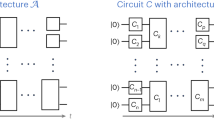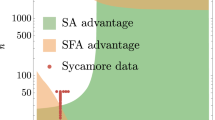Abstract
A critical milestone on the path to useful quantum computers is the demonstration of a quantum computation that is prohibitively hard for classical computers—a task referred to as quantum supremacy. A leading near-term candidate is sampling from the probability distributions of randomly chosen quantum circuits, which we call random circuit sampling (RCS). RCS was defined with experimental realizations in mind, leaving its computational hardness unproven. Here we give strong complexity-theoretic evidence of classical hardness of RCS, placing it on par with the best theoretical proposals for supremacy. Specifically, we show that RCS satisfies an average-case hardness condition, which is critical to establishing computational hardness in the presence of experimental noise. In addition, it follows from known results that RCS also satisfies an anti-concentration property, namely that errors in estimating output probabilities are small with respect to the probabilities themselves. This makes RCS the first proposal for quantum supremacy with both of these properties. Finally, we also give a natural condition under which an existing statistical measure, cross-entropy, verifies RCS, as well as describe a new verification measure that in some formal sense maximizes the information gained from experimental samples.
This is a preview of subscription content, access via your institution
Access options
Access Nature and 54 other Nature Portfolio journals
Get Nature+, our best-value online-access subscription
$29.99 / 30 days
cancel any time
Subscribe to this journal
Receive 12 print issues and online access
$209.00 per year
only $17.42 per issue
Buy this article
- Purchase on Springer Link
- Instant access to full article PDF
Prices may be subject to local taxes which are calculated during checkout
Similar content being viewed by others
Data availability
The data that support the plots within this paper and other findings of this study are available from the corresponding author upon reasonable request.
References
Bernstein, E. & Vazirani, U. V. Quantum complexity theory. In Proc. 25th Annual ACM Symposium on Theory of Computing (eds Kosaraju, S. R. et al.) 11–20 (ACM, 1993).
Simon, D. R. On the power of quantum cryptography. In Proc. 35th Annual Symposium on Foundations of Computer Science 116–123 (IEEE Computer Society, 1994).
Shor, P. W. Polynomial-time algorithms for prime factorization and discrete logarithms on a quantum computer. SIAM Rev. 41, 303–332 (1999).
Mohseni, M. et al. Commercialize quantum technologies in five years. Nature 543, 171–174 (2017).
Kandala, A. et al. Hardware-efficient variational quantum eigensolver for small molecules and quantum magnets. Nature 549, 242–246 (2017).
Zhang, J. et al. Observation of a many-body dynamical phase transition with a 53-qubit quantum simulator. Nature 551, 601–604 (2017).
Preskill, J. Quantum computing in the NISQ era and beyond. Quantum 2, 79 (2018).
Aaronson, S. & Arkhipov, A. The computational complexity of linear optics. In Proc. 43rd Annual ACM Symposium on Theory of Computing (eds Fortnow, L. & Vadhan, S. P.) 333–342 (ACM, 2011).
Boixo, S. et al. Characterizing quantum supremacy in near-term devices. Nat. Phys. 14, 595–600 (2018).
Bremner, M. J., Jozsa, R. & Shepherd, D. J. Classical simulation of commuting quantum computations implies collapse of the polynomial hierarchy. In Proc. Royal Society of London A: Mathematical, Physical and Engineering Sciences 459–472 (The Royal Society, 2010).
Spring, J. B. et al. Boson sampling on a photonic chip. Science 339, 798–801 (2013).
Broome, M. A. et al. Photonic boson sampling in a tunable circuit. Science 339, 794–798 (2013).
Tillmann, M. et al. Experimental boson sampling. Nat. Photonics 7, 540–544 (2013).
Crespi, A. et al. Integrated multimode interferometers with arbitrary designs for photonic boson sampling. Nat. Photonics 7, 545–549 (2013).
Neville, A. et al. No imminent quantum supremacy by boson sampling. Nat. Phys. 13, 1153–1157 (2017).
Clifford, P. & Clifford, R. The classical complexity of boson sampling. In Proc. 29th Annual ACM-SIAM Symposium on Discrete Algorithms, (ed. Czumaj, A.) 146–155 (SIAM, 2018).
Martinis, J. The quantum space race (2018). Plenary talk at Quantum Information Processing (QIP) 2018. TU Delft https://collegerama.tudelft.nl/Mediasite/Showcase/qip2018/Channel/qip-day3 (2018)
Brandão, F. G. & Horodecki, M. Exponential quantum speed-ups are generic. Quantum Inf. Comput. 13, 901–924 (2013).
Hangleiter, D., Bermejo-Vega, J., Schwarz, M. & Eisert, J. Anticoncentration theorems for schemes showing a quantum speedup. Quantum 2, 65 (2018).
Terhal, B. M. & DiVincenzo, D. P. Adaptive quantum computation, constant depth quantum circuits and Arthur–Merlin games. Quantum Inf. Comput. 4, 134–145 (2004).
Morimae, T., Fujii, K. & Fitzsimons, J. F. Hardness of classically simulating the one-clean-qubit model. Phys. Rev. Lett. 112, 130502 (2014).
Farhi, E. & Harrow, A. W. Quantum supremacy through the quantum approximate optimization algorithm. Preprint at https://arxiv.org/abs/1602.07674 (2016).
Bouland, A, Mancinska, L. & Zhang, X. Complexity classification of two-qubit commuting Hamiltonians. In Proc. 31st Conference on Computational Complexity (CCC 2016), vol. 50 of Leibniz International Proceedings in Informatics (LIPIcs) (ed. Raz, R.) 28:1–28:33 (Schloss Dagstuhl-Leibniz-Zentrum fuer Informatik, 2016).
Lipton, R. J. New directions in testing. In Proc. Distributed Computing and Cryptography, vol. 2 of DIMACS Series in Discrete Mathematics and Theoretical Computer Science (eds Feigenbaum, J. & Merritt, M.) 191–202 (DIMACS/AMS, 1991).
Pastawski, F., Yoshida, B., Harlow, D. & Preskill, J. Holographic quantum error-correcting codes: Toy models for the bulk/boundary correspondence. J. High Energy Phys. 2015, 149 (2015).
Fefferman, B. & Umans, C. On the power of quantum Fourier sampling. In Proc. 11th Conference on the Theory of Quantum Computation, Communication and Cryptography, vol. 61 of Leibniz International Proceedings in Informatics (LIPIcs) (ed. Broadbent, A.) 1:1–1:19 (Schloss Dagstuhl-Leibniz-Zentrum fuer Informatik, 2016).
Bremner, M. J., Montanaro, A. & Shepherd, D. J. Average-case complexity versus approximate simulation of commuting quantum computations. Phys. Rev. Lett. 117, 080501 (2016).
Aaronson, S. & Chen, L. Complexity-theoretic foundations of quantum supremacy experiments. In Proc. 32nd Computational Complexity Conference, vol. 79 of LIPIcs (ed. O’Donnell, R.) 22:1–22:67 (Schloss Dagstuhl-Leibniz-Zentrum fuer Informatik, 2017).
Bremner, M. J., Montanaro, A. & Shepherd, D. J. Achieving quantum supremacy with sparse and noisy commuting quantum computations. Quantum 1, 8 (2017).
Morimae, T. Hardness of classically sampling the one-clean-qubit model with constant total variation distance error. Phys. Rev. A 96, 040302 (2017).
Bouland, A, Fitzsimons, J. F. & Koh, D. E . Complexity classification of conjugated Clifford circuits. In Proc. 33rd Computational Complexity Conference, vol. 102 of Leibniz International Proceedings in Informatics (LIPIcs) (ed. Servedio, R. A.) 21:1–21:25 (Schloss Dagstuhl-Leibniz-Zentrum fuer Informatik: 2018).
Mann, R. L. & Bremner, M. J. On the complexity of random quantum computations and the Jones polynomial. Preprint at https://arxiv.org/abs/1711.00686 (2017).
Neill, C. et al. A blueprint for demonstrating quantum supremacy with superconducting qubits. Science 360, 195–199 (2018).
Boixo, S., Smelyanskiy, V. N. & Neven, H. Fourier analysis of sampling from noisy chaotic quantum circuits. Preprint at https://arxiv.org/abs/1708.01875 (2017).
Harrow, A. W. & Low, R. A. Random quantum circuits are approximate 2-designs. Commun. Math. Phys. 291, 257–302 (2009).
Welch, L. & Berlekamp, E. Error correction for algebraic block codes. US patent 4,633,470 (1986).
Gemmell, P., Lipton, R., Rubinfeld, R., Sudan, M. & Wigderson, A. Self-testing/correcting for polynomials and for approximate functions. In Proc. 23rd Annual ACM Symposium on Theory of Computing (eds Koutsougeras, C. & Vitter, J. S.) 33–42 (ACM, 1991).
Valiant, L. The complexity of computing the permanent. Theor. Comput. Sci. 8, 189–201 (1979).
Acknowledgements
We thank S. Aaronson, D. Aharonov, F. Brandão, M. Coudron, A. Deshpande, T. Gur, Z. Landau, N. Spooner and H. Yuen for helpful discussions. A.B., B.F., C.N. and U.V. were supported by ARO grant W911NF-12-1-0541 and NSF grant CCF-1410022 and a Vannevar Bush faculty fellowship. B.F. is supported in part by an Air Force Office of Scientific Research Young Investigator Program award number FA9550-18-1-0148. Parts of this work were done at the Kavli Institute for Theoretical Physics. Portions of this paper are a contribution of NIST, an agency of the US government, and are not subject to US copyright.
Author information
Authors and Affiliations
Contributions
All authors contributed equally to this work; author ordering is alphabetical.
Corresponding author
Ethics declarations
Competing interests
The authors declare no competing interests.
Additional information
Publisher’s note: Springer Nature remains neutral with regard to jurisdictional claims in published maps and institutional affiliations.
Supplementary information
Supplementary Information
Supplementary Information
Rights and permissions
About this article
Cite this article
Bouland, A., Fefferman, B., Nirkhe, C. et al. On the complexity and verification of quantum random circuit sampling. Nature Phys 15, 159–163 (2019). https://doi.org/10.1038/s41567-018-0318-2
Received:
Accepted:
Published:
Issue Date:
DOI: https://doi.org/10.1038/s41567-018-0318-2
This article is cited by
-
A framework for demonstrating practical quantum advantage: comparing quantum against classical generative models
Communications Physics (2024)
-
Logical quantum processor based on reconfigurable atom arrays
Nature (2024)
-
Random Quantum Circuits Transform Local Noise into Global White Noise
Communications in Mathematical Physics (2024)
-
The hardness of random quantum circuits
Nature Physics (2023)
-
Interactive cryptographic proofs of quantumness using mid-circuit measurements
Nature Physics (2023)



